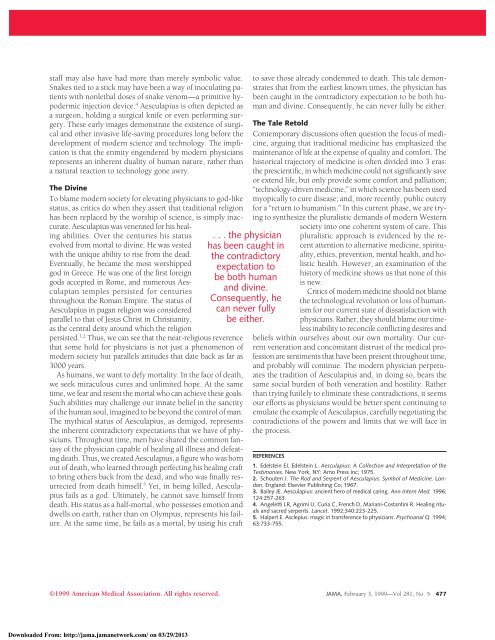JMS0203
JMS0203
JMS0203
You also want an ePaper? Increase the reach of your titles
YUMPU automatically turns print PDFs into web optimized ePapers that Google loves.
staff may also have had more than merely symbolic value.<br />
Snakes tied to a stick may have been a way of inoculating patients<br />
with nonlethal doses of snake venom—a primitive hypodermic<br />
injection device. 4 Aesculapius is often depicted as<br />
a surgeon, holding a surgical knife or even performing surgery.<br />
These early images demonstrate the existence of surgical<br />
and other invasive life-saving procedures long before the<br />
development of modern science and technology. The implication<br />
is that the enmity engendered by modern physicians<br />
represents an inherent duality of human nature, rather than<br />
a natural reaction to technology gone awry.<br />
The Divine<br />
To blame modern society for elevating physicians to god-like<br />
status, as critics do when they assert that traditional religion<br />
has been replaced by the worship of science, is simply inac-<br />
curate. Aesculapius was venerated for his healing<br />
abilities. Over the centuries his status<br />
evolved from mortal to divine. He was vested<br />
with the unique ability to rise from the dead.<br />
Eventually, he became the most worshipped<br />
god in Greece. He was one of the first foreign<br />
gods accepted in Rome, and numerous Aesculapian<br />
temples persisted for centuries<br />
throughout the Roman Empire. The status of<br />
Aesculapius in pagan religion was considered<br />
parallel to that of Jesus Christ in Christianity,<br />
as the central deity around which the religion<br />
persisted. 1,2 Thus, we can see that the near-religious reverence<br />
that some hold for physicians is not just a phenomenon of<br />
modern society but parallels attitudes that date back as far as<br />
3000 years.<br />
As humans, we want to defy mortality. In the face of death,<br />
we seek miraculous cures and unlimited hope. At the same<br />
time, we fear and resent the mortal who can achieve these goals.<br />
Such abilities may challenge our innate belief in the sanctity<br />
of the human soul, imagined to be beyond the control of man.<br />
The mythical status of Aesculapius, as demigod, represents<br />
the inherent contradictory expectations that we have of physicians.<br />
Throughout time, men have shared the common fantasy<br />
of the physician capable of healing all illness and defeating<br />
death. Thus, we created Aesculapius, a figure who was born<br />
out of death, who learned through perfecting his healing craft<br />
to bring others back from the dead, and who was finally resurrected<br />
from death himself. 5 Yet, in being killed, Aesculapius<br />
fails as a god. Ultimately, he cannot save himself from<br />
death. His status as a half-mortal, who possesses emotion and<br />
dwells on earth, rather than on Olympus, represents his failure.<br />
At the same time, he fails as a mortal, by using his craft<br />
. . . the physician<br />
has been caught in<br />
the contradictory<br />
expectation to<br />
be both human<br />
and divine.<br />
Consequently, he<br />
can never fully<br />
be either.<br />
to save those already condemned to death. This tale demonstrates<br />
that from the earliest known times, the physician has<br />
been caught in the contradictory expectation to be both human<br />
and divine. Consequently, he can never fully be either.<br />
The Tale Retold<br />
Contemporary discussions often question the focus of medicine,<br />
arguing that traditional medicine has emphasized the<br />
maintenance of life at the expense of quality and comfort. The<br />
historical trajectory of medicine is often divided into 3 eras:<br />
the prescientific, in which medicine could not significantly save<br />
or extend life, but only provide some comfort and palliation;<br />
“technology-driven medicine,” in which science has been used<br />
myopically to cure disease; and, more recently, public outcry<br />
for a “return to humanism.” In this current phase, we are trying<br />
to synthesize the pluralistic demands of modern Western<br />
society into one coherent system of care. This<br />
pluralistic approach is evidenced by the recent<br />
attention to alternative medicine, spirituality,<br />
ethics, prevention, mental health, and holistic<br />
health. However, an examination of the<br />
history of medicine shows us that none of this<br />
is new.<br />
Critics of modern medicine should not blame<br />
the technological revolution or loss of humanism<br />
for our current state of dissatisfaction with<br />
physicians. Rather, they should blame our timeless<br />
inability to reconcile conflicting desires and<br />
beliefs within ourselves about our own mortality. Our current<br />
veneration and concomitant distrust of the medical profession<br />
are sentiments that have been present throughout time,<br />
and probably will continue. The modern physician perpetuates<br />
the tradition of Aesculapius and, in doing so, bears the<br />
same social burden of both veneration and hostility. Rather<br />
than trying futilely to eliminate these contradictions, it seems<br />
our efforts as physicians would be better spent continuing to<br />
emulate the example of Aesculapius, carefully negotiating the<br />
contradictions of the powers and limits that we will face in<br />
the process.<br />
REFERENCES<br />
1. Edelstein EJ, Edelstein L. Aesculapius: A Collection and Interpretation of the<br />
Testimonies. New York, NY: Arno Press Inc; 1975.<br />
2. Schouten J. The Rod and Serpent of Aesculapius: Symbol of Medicine. London,<br />
England: Elsevier Publishing Co; 1967.<br />
3. Bailey JE. Aesculapius: ancient hero of medical caring. Ann Intern Med. 1996;<br />
124:257-263.<br />
4. Angeletti LR, Agrimi U, Curia C, French D, Mariani-Costantini R. Healing rituals<br />
and sacred serpents. Lancet. 1992;340:223-225.<br />
5. Halpert E. Asclepius: magic in transference to physicians. Psychoanal Q. 1994;<br />
63:733-755.<br />
©1999 American Medical Association. All rights reserved. JAMA, February 3, 1999—Vol 281, No. 5 477<br />
Downloaded From: http://jama.jamanetwork.com/ on 03/29/2013



